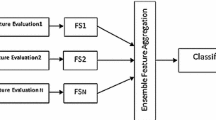Abstract
Using an ensemble of classifiers instead of a single classifier has been shown to improve generalization performance in many pattern recognition problems. However, the extent of such improvement depends greatly on the amount of correlation among the errors of the base classifiers. Therefore, reducing those correlations while keeping the classifiers’ performance levels high is an important area of research. In this article, we explore Input Decimation (ID), a method which selects feature subsets for their ability to discriminate among the classes and uses these subsets to decouple the base classifiers. We provide a summary of the theoretical benefits of correlation reduction, along with results of our method on two underwater sonar data sets, three benchmarks from the Probenl/UCI repositories, and two synthetic data sets. The results indicate that input decimated ensembles outperform ensembles whose base classifiers use all the input features; randomly selected subsets of features; and features created using principal components analysis, on a wide range of domains.
Similar content being viewed by others
Author information
Authors and Affiliations
Additional information
ID="A1"Correspondance and offprint requests to: Kagan Tumer, NASA Ames Research Center, Moffett Field, CA, USA
Rights and permissions
About this article
Cite this article
Tumer, K., Oza, N. Input decimated ensembles. Pattern Anal Appl 6, 65–77 (2003). https://doi.org/10.1007/s10044-002-0181-7
Issue Date:
DOI: https://doi.org/10.1007/s10044-002-0181-7




